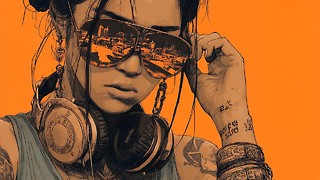Art Movements for the Non-Arts Student: Futurism
In this weekly series, Sam Hunt gives us a basic guide to major art movements; the perfect foundation for anyone keen to learn about the context of popular art. We look to the future in our second lesson
Where next to go in the exploration of art? Well, how about we go back to the Futurism.
So what did it all mean? Futurists, surprisingly enough, thought a lot about the future.
They looked at the changing face of the technological world and pondered on the haze of futurity; on an age of new engines, new speeds, and the advancements in transportation occurring in the appearance of modernity.

The movement emerged predominantly in Italy, founded when the painter, poet and polemicist Filippo Tommaso Marinetti (1876-1944) produced the Futurist Manifesto in 1909. He was not alone for long: Umberto Boccioni, Giacomo Balla, Luigi Russolo, Gino Severini and Carlo Carrà then published the Technical Manifesto of Futurist Painting in 1910, whilst also presenting their ideas in the periodical Lacerba and opened exhibitions across the capitals of Europe.
Their position was anti-traditional – their paintings did away with the static image, instead depicting movement and the passage of time, whilst also beginning to reject the fixed vanishing point. They were fixed upon a new viewpoint – a new understanding of reality, going beyond the visible to present intricate realities beyond the eye’s usual perception, and following the science of the time by moving away from ideas of preconceived normality. The world was changing, so the Futurists moved with it.

This new conception was centred upon a theory of “universal dynamism”, where man was master over the machine in a society that was mutating with scientific discoveries and technological advancement. Speed was injected into painting, where it fractured solidity and created kinetic forms, setting the space in the painting at the same speed as that of the shifting world.
As their work evolved it became more geometric, lacking definite boundaries. The presence of letters and signs offered a few distinguishable features for the eye’s recognition, aiding comprehension. Many of the subjects were painted as two dimensional, where light became solidified into beams and shapes.
What appeared through Futurism was an amalgamation of other thought strands: the shifting light and the strolling crowds of European boulevards, as represented by the Impressionists and the Neo-Impressionists, became twisted and jagged under the influence of the Cubist movement. Futurism equally affected certain groups like the Blaue Reiter (see last week’s guide to Expressionism), some Cubist works, and Dadaism, whilst inspiring certain figures like Marcel Duchamp, George Grosz and Otto Dix.
Although Futurism flourished in Italy until about 1916, classical Futurism is said to have ended around 1914. Nevertheless, offshoots of the movement continued to emerge for years to come.

If, on your casual gallery walks, you see the names of Umberto Boccioni or Gino Severini – or any of those listed above in the movement’s creation – then think Futurism.
The Futurist movement still travels from the past to affect the art of present day. And, if I might inject some unnecessary cheese, I’m sure it will still be remembered in the Future too.
 News / Meta opens £12 million lab in Cambridge 11 July 2025
News / Meta opens £12 million lab in Cambridge 11 July 2025 Lifestyle / Reflections on rowing10 July 2025
Lifestyle / Reflections on rowing10 July 2025 News / Write for Varsity this Michaelmas13 July 2025
News / Write for Varsity this Michaelmas13 July 2025 Features / How to catch a coat thief13 July 2025
Features / How to catch a coat thief13 July 2025 Comment / What is originality, anyway? 14 July 2025
Comment / What is originality, anyway? 14 July 2025








